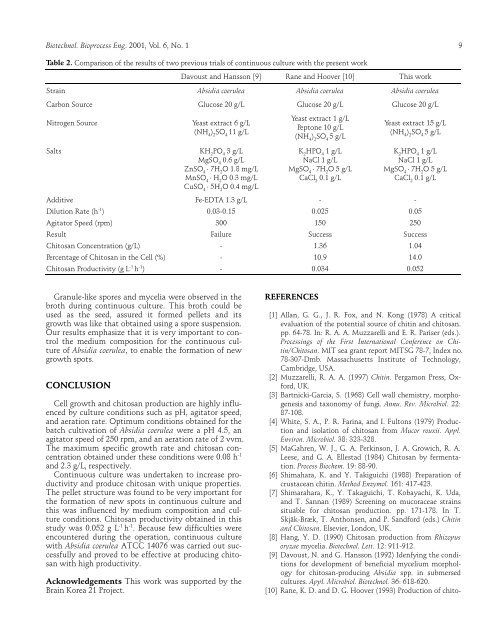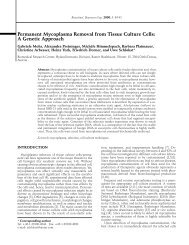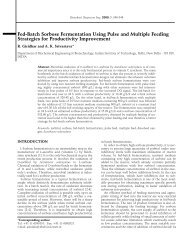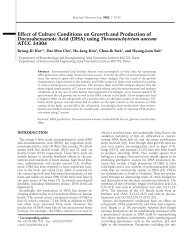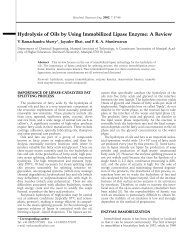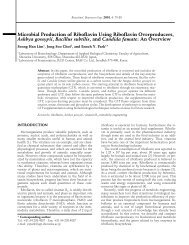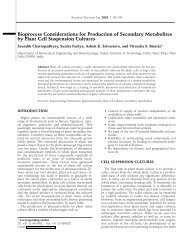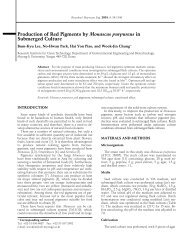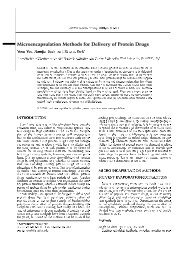Optimization of Culture Conditions and Continuous Production of ...
Optimization of Culture Conditions and Continuous Production of ...
Optimization of Culture Conditions and Continuous Production of ...
Create successful ePaper yourself
Turn your PDF publications into a flip-book with our unique Google optimized e-Paper software.
Biotechnol. Bioprocess Eng. 2001, Vol. 6, No. 1 9Table 2. Comparison <strong>of</strong> the results <strong>of</strong> two previous trials <strong>of</strong> continuous culture with the present workDavoust <strong>and</strong> Hansson [9] Rane <strong>and</strong> Hoover [10] This workStrain Absidia coerulea Absidia coerulea Absidia coeruleaCarbon Source Glucose 20 g/L Glucose 20 g/L Glucose 20 g/LNitrogen SourceYeast extract 6 g/L(NH 4) 2SO 411 g/LYeast extract 1 g/LPeptone 10 g/L(NH 4) 2SO 45 g/LYeast extract 15 g/L(NH 4) 2SO 45 g/LSaltsKH 2PO 43 g/LMgSO 40.6 g/LZnSO 4⋅ 7H 2O 1.8 mg/LMnSO 4⋅ H 2O 0.3 mg/LCuSO 4⋅ 5H 2O 0.4 mg/LK 2HPO 41 g/LNaCl 1 g/LMgSO 4⋅ 7H 2O 5 g/LCaCl 20.1 g/LK 2HPO 41 g/LNaCl 1 g/LMgSO 4⋅ 7H 2O 5 g/LCaCl 20.1 g/LAdditive Fe-EDTA 1.3 g/L - -Dilution Rate (h -1 ) 0.03-0.15 0.025 0.05Agitator Speed (rpm) 300 150 250Result Failure Success SuccessChitosan Concentration (g/L) - 1.36 1.04Percentage <strong>of</strong> Chitosan in the Cell (%) - 10.9 14.0Chitosan Productivity (g L -1 h -1 ) - 0.034 0.052Granule-like spores <strong>and</strong> mycelia were observed in thebroth during continuous culture. This broth could beused as the seed, assured it formed pellets <strong>and</strong> itsgrowth was like that obtained using a spore suspension.Our results emphasize that it is very important to controlthe medium composition for the continuous culture<strong>of</strong> Absidia coerulea, to enable the formation <strong>of</strong> newgrowth spots.CONCLUSIONCell growth <strong>and</strong> chitosan production are highly influencedby culture conditions such as pH, agitator speed,<strong>and</strong> aeration rate. Optimum conditions obtained for thebatch cultivation <strong>of</strong> Absidia coerulea were a pH 4.5, anagitator speed <strong>of</strong> 250 rpm, <strong>and</strong> an aeration rate <strong>of</strong> 2 vvm.The maximum specific growth rate <strong>and</strong> chitosan concentrationobtained under these conditions were 0.08 h -1<strong>and</strong> 2.3 g/L, respectively.<strong>Continuous</strong> culture was undertaken to increase productivity<strong>and</strong> produce chitosan with unique properties.The pellet structure was found to be very important forthe formation <strong>of</strong> new spots in continuous culture <strong>and</strong>this was influenced by medium composition <strong>and</strong> cultureconditions. Chitosan productivity obtained in thisstudy was 0.052 g L -1 h -1 . Because few difficulties wereencountered during the operation, continuous culturewith Absidia coerulea ATCC 14076 was carried out successfully<strong>and</strong> proved to be effective at producing chitosanwith high productivity.Acknowledgements This work was supported by theBrain Korea 21 Project.REFERENCES[1] Allan, G. G., J. R. Fox, <strong>and</strong> N. Kong (1978) A criticalevaluation <strong>of</strong> the potential source <strong>of</strong> chitin <strong>and</strong> chitosan.pp. 64-78. In: R. A. A. Muzzarelli <strong>and</strong> E. R. Pariser (eds.).Processings <strong>of</strong> the First International Conference on Chitin/Chitosan.MIT sea grant report MITSG 78-7, Index no.78-307-Dmb. Massachusetts Institute <strong>of</strong> Technology,Cambridge, USA.[2] Muzzarelli, R. A. A. (1997) Chitin. Pergamon Press, Oxford,UK.[3] Bartnicki-Garcia, S. (1968) Cell wall chemistry, morphogenesis<strong>and</strong> taxonomy <strong>of</strong> fungi. Annu. Rev. Microbiol. 22:87-108.[4] White, S. A., P. R. Farina, <strong>and</strong> I. Fultons (1979) <strong>Production</strong><strong>and</strong> isolation <strong>of</strong> chitosan from Mucor rouxii. Appl.Environ. Microbiol. 38: 323-328.[5] MaGahren, W. J., G. A. Perkinson, J. A. Growich, R. A.Leese, <strong>and</strong> G. A. Ellestad (1984) Chitosan by fermentation.Process Biochem. 19: 88-90.[6] Shimahara, K. <strong>and</strong> Y. Takiguichi (1988) Preparation <strong>of</strong>crustacean chitin. Method Enzymol. 161: 417-423.[7] Shimarahara, K., Y. Takaguichi, T. Kobayachi, K. Uda,<strong>and</strong> T. Sannan (1989) Screening on mucoraceae strainssituable for chitosan production. pp. 171-178. In T.Skjäk-Bræk, T. Anthonsen, <strong>and</strong> P. S<strong>and</strong>ford (eds.) Chitin<strong>and</strong> Chitosan. Elsevier, London, UK.[8] Hang, Y. D. (1990) Chitosan production from Rhizopusoryzae mycelia. Biotechnol. Lett. 12: 911-912.[9] Davoust, N. <strong>and</strong> G. Hansson (1992) Idenfying the conditionsfor development <strong>of</strong> beneficial mycelium morphologyfor chitosan-producing Absidia spp. in submersedcultures. Appl. Microbiol. Biotechnol. 36: 618-620.[10] Rane, K. D. <strong>and</strong> D. G. Hoover (1993) <strong>Production</strong> <strong>of</strong> chito-


